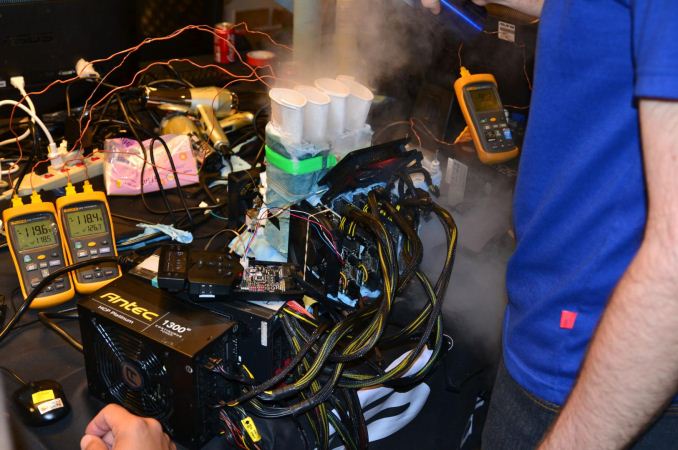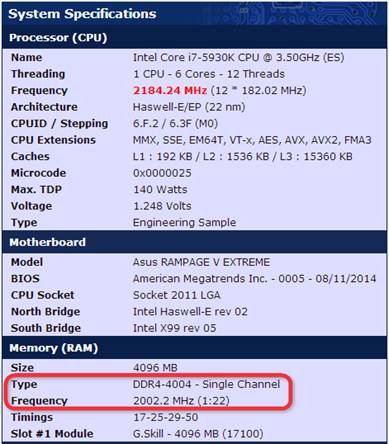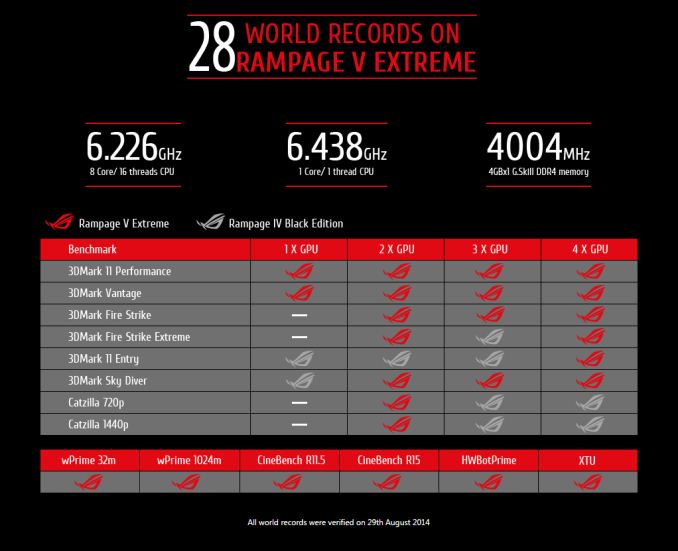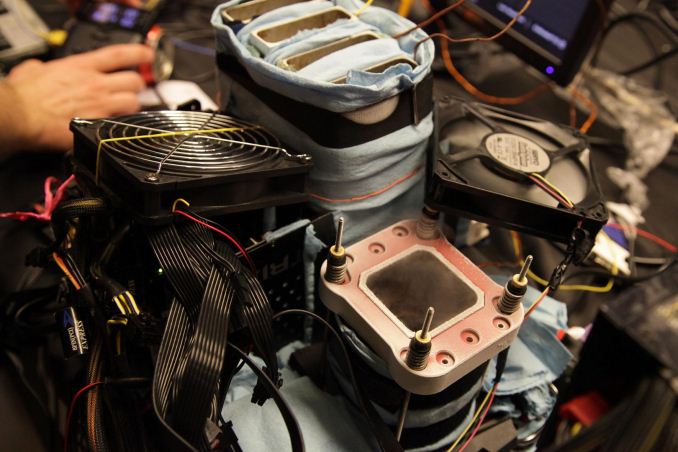Haswell-E Comes, ASUS and G.Skill Take Overclocking Records
by Ian Cutress on September 1, 2014 5:28 AM EST- Posted in
- Memory
- CPUs
- G.Skill
- Motherboards
- Asus
- Overclocking

In our Haswell-E coverage we did some basic 24/7 type overclocking suitable for the system under the desk, and there will be users with custom loops willing to go a bit further. Overclocking beyond this requires a level of skill and exotic coolants not intended for the average user, akin to what drag cars are to normal runabouts. We have previously reported on overclocking events where the world’s best battle it out to see who can get the best results – to see who can do that quarter mile the fastest. With the launch of the new Haswell-E platform, each of the companies invested in overclocking performance products got their best in-house teams for day one results. Both ASUS and G.Skill are two of the big winners.
With a new memory system behaving differently in terms of voltage and setup, G.Skill and ASUS worked together to hit DDR4-4004 MHz using an i7-5930K and an ASUS Rampage V Extreme, with the memory at a rather tame 1.5 volts (compared to 1.2 volts standard, 1.35 volts for high performance kits). This was using a soon-to-be-announced DDR4-3300 memory kit from G.Skill. Absolute DRAM frequency records are similar to CPU frequency records: performed with a stripped out system with the aim to get that frequency number the highest. So while the record was performed under liquid nitrogen and with a single memory module, and ultimately has little real world value, both ASUS and G.Skill can claim together that they have the world’s fastest memory.
ASUS’ level of records go substantially deeper than just memory. After day one of Haswell-E launch, ASUS held no fewer than 37 records across CPU frequency, CPU absolute performance and popular 3D benchmarks such as 3DMark and Catzilla.
26 of these records comes from the new Rampage V Extreme paired with Haswell-E CPUs, with records coming from professional overclockers such as Shamino, 8Pack, Wizerty, Hazzan, Gunsligner, Slamms and Elmor. For example, the 3DMark Fire Strike 4-way record was performed using an i7-5960X at 5.624 GHz (+87% overclock) with four ASUS Matrix R9 290X cards at 1460/1750 (+46% overclock), G.Skill memory at DDR4-3000 C12 and the whole system under liquid nitrogen.
The records are continuously evolving, for example a new 8-core Cinebench R15 record has been posted in the past 24 hours with an MSI motherboard and a CPU at 5930 MHz. As overclockers start to understand the platform and the motherboard manufacturers update their BIOSes to be more amenable to extreme overclocking settings, no doubt there will be more records in the future, especially for benchmarks that can use all eight threads. Ultimately one might ask the point of all this – as an overclocker myself, sometimes getting a bigger number than the other guy is just more fun! Also learning how this hardware works outside their suggested thermal window can be an interesting experience in itself. Many of these manufacturers also use their records as an advertising tool, to say they have/support the fastest on the market as a nod towards their commitment to produce the better hardware with features that help regular users get the most from their setups.













16 Comments
View All Comments
mapesdhs - Monday, September 1, 2014 - link
Re the Firestrike record, I can't help noticing the caveats shown on the
3DMark result page; quote:
1. Benchmark tessellation load modified by AMD Catalyst driver, result invalid. Check your
video driver settings.
2. Time measuring inaccurate. Results are invalid.
3. System info is too old compared to the submit date of this result. Results submitted after
november 2013 should have at least SystemInfo version 4.20.
4. Graphics driver is not approved.
Items 2 to 4 don't bother me so much, but item 1 is distinctly worrysome. The drivers
should not be meddling with the tesselation mode used in the test.
Ian.
mapesdhs - Monday, September 1, 2014 - link
To clarify what I mean btw, compare to result no. 2394676 on the 3dmark site,which employs four 780Tis. It has lower gfx/physics scores, a similar but lower
overall score, yet a 20% higher combined score - how can that be? Very odd...
Ian.
Iketh - Monday, September 1, 2014 - link
lol #2 doesn't bother you??? how do you think they determine the scores???? do you know what the S stands for in FPS?Ian Cutress - Monday, September 1, 2014 - link
To answer:1) Normally records are set within a standard of rules. Futuremark doesn't allow modifications like this, even though it explicitly has the option in AMD Catalyst under performance. HWBot.org is often used more to ratify benchmarks because they allow Catalyst level of changes and the following:
2) Happens more often than not on overclocked runs, although it only really matters for Windows 8 benchmarking where the internal clocks can be fooled. HWBot has banned Windows 8 for this reason.
3) Due to detection issues with Systeminfo on the latest hardware, it does not always work and you have to find a version that does, or doesn't take 5 minutes to open/crash the system. Again, HWBot is agnostic to this FM applied limitation, because HWBot use CPU-Z and GPU-Z for hardware verification.
4) Another symptom of using non WHQL drivers and FM's limitation. Most overclockers will use any driver that gives a better number, whether they are beta or not.
In general, competitive overclockers use HWBot or CPU-Z as the overriding rule in absolute world records due to FM's limitations which can severely hamper world record attempts. Imagine overclocking live for a competition, and in the final run of the day the seemingly random 'Time Measuring Inaccurate' crops up in Windows 7, then for the result not to count.
You could consider it being 'world record' by BDO or WDC, where in the world of Darts there are two awarding bodies. In overclocking, most competitive overclockers defer to HWBot/CPU-Z.
mapesdhs - Monday, September 1, 2014 - link
Thanks for the clarification! 8)
Iketh, I wasn't bothered by #2 for the very reasons Ian mentions (already knew about
the clock issue from chats on the FM forums).
Ian.
mapesdhs - Monday, September 1, 2014 - link
One thing though, I'm still confused how fs result 2394676 gives a 20% higher Combined
score. Don't get that at all. Any ideas Ian how that can be? Note the fps numbers for the
tests show the same differences.
Ian.
MrSpadge - Monday, September 1, 2014 - link
Yes, one might question the value of such records. What I'd rather see are energy efficient 24/7 number crunching setups. This implies voltages in the range of 0.9 - 1.1 V instead of the usual 1.3+ V for heavy OC. Personally I'm sticking to ~4.0 GHz at a little over 1.0 V with 22 nm Intel CPUs. Yet it would be intersting if I could save some more money by getting the same performance with e.g. an MSI Green mainboard upon my next purchase.Flunk - Monday, September 1, 2014 - link
LN2 results are utterly pointless, the point of overclocking is squeezing extra performance out of hardware. If all you're doing while the system is running is keeping it running you're not getting anything out of it. I still think they need to add a 24 hour hands-off burn in test to every overclocking competition. It would keep the competition real and add suspense. As is this proves nothing, shows nothing and is pointless.ShieTar - Tuesday, September 2, 2014 - link
So, running 100 m in under 10 seconds wearing shorts is pointless, because you can't run 10 Km in under 1000 seconds wearing street clothes? Good to know.wolrah - Tuesday, September 2, 2014 - link
Yes it is pointless, there's not really any real-world applicability. That doesn't make it not fun to compete anyways, but in the end it's just a pissing contest."Normal" levels of competition in most things end up benefiting the average user because something learned while pushing the performance envelope can often be translated to day-to-day use, like how racers learned to tame turbochargers and these days we have cars that'll do 30+ MPG while putting down 300+ HP from two liters.
LN2 on the other hand is more comparable to Top Fuel drag racing. It comes from a motorsport where lessons learned on the strip made production cars better, but it's been taken to such an extreme that pretty much anything they do is irrelevant to anyone not also rebuilding their motors after every run.
A machine that is technically the fastest at something, but requires a hardware configuration no one would ever run (4GB single stick) and a cooling system that only works unattended for a matter of minutes is not actually useful. It's nifty and more power to 'em, but means absolutely nothing to someone who overclocks to gain performance on things I'm doing in the real world.
Show me the best performance you can get with a 24/7 cooling system and a realistic RAM configuration, then I'm going to be a lot more interested.